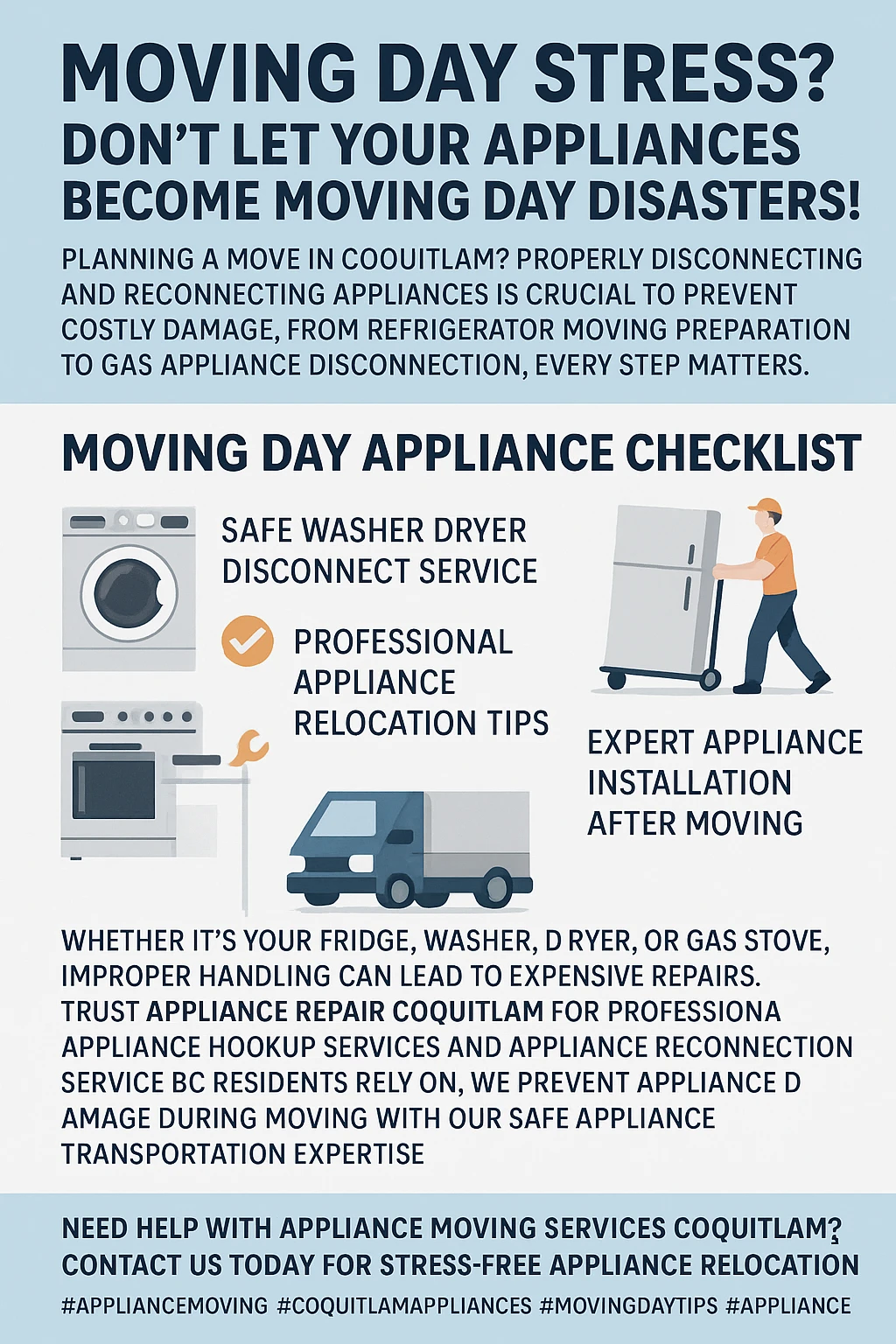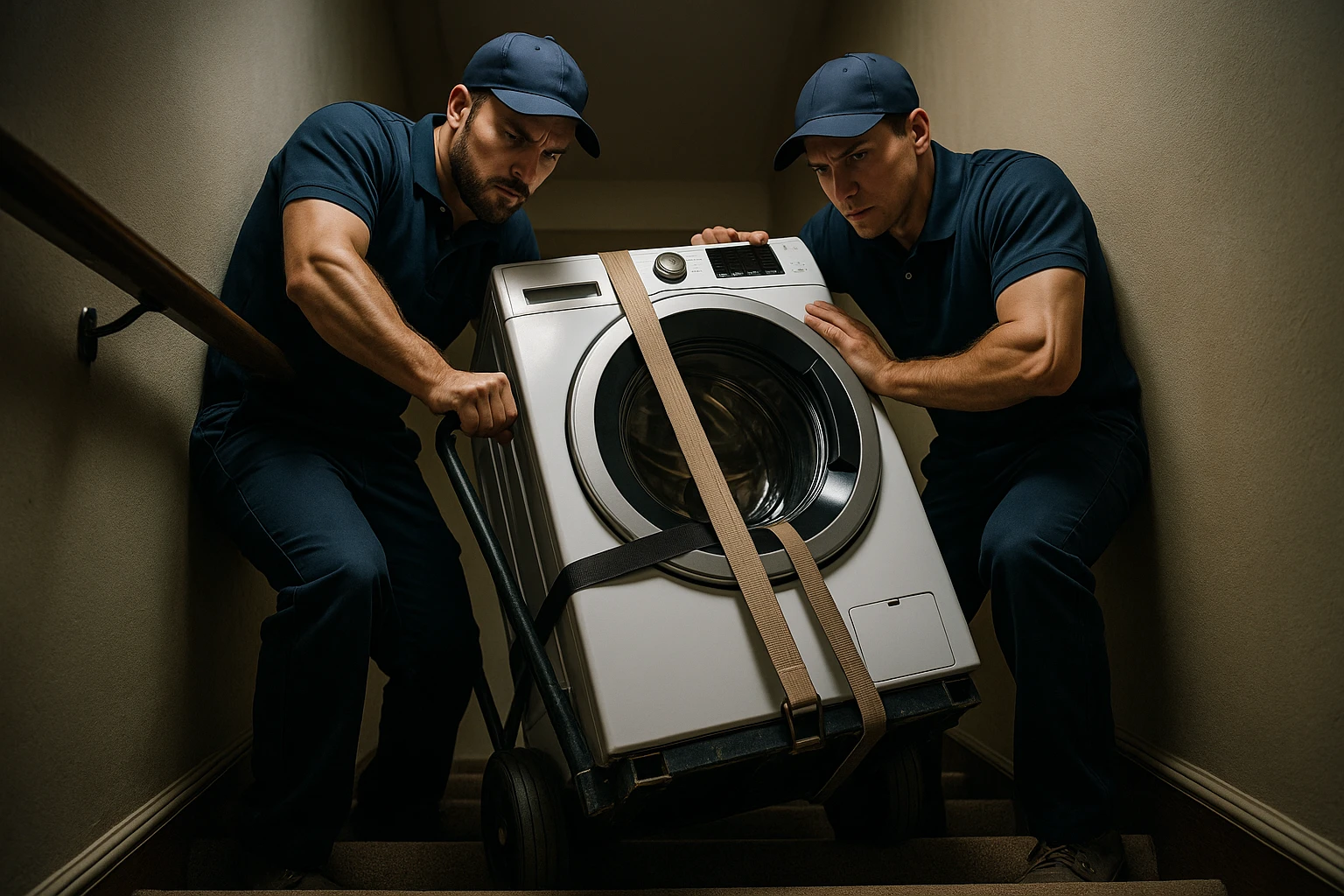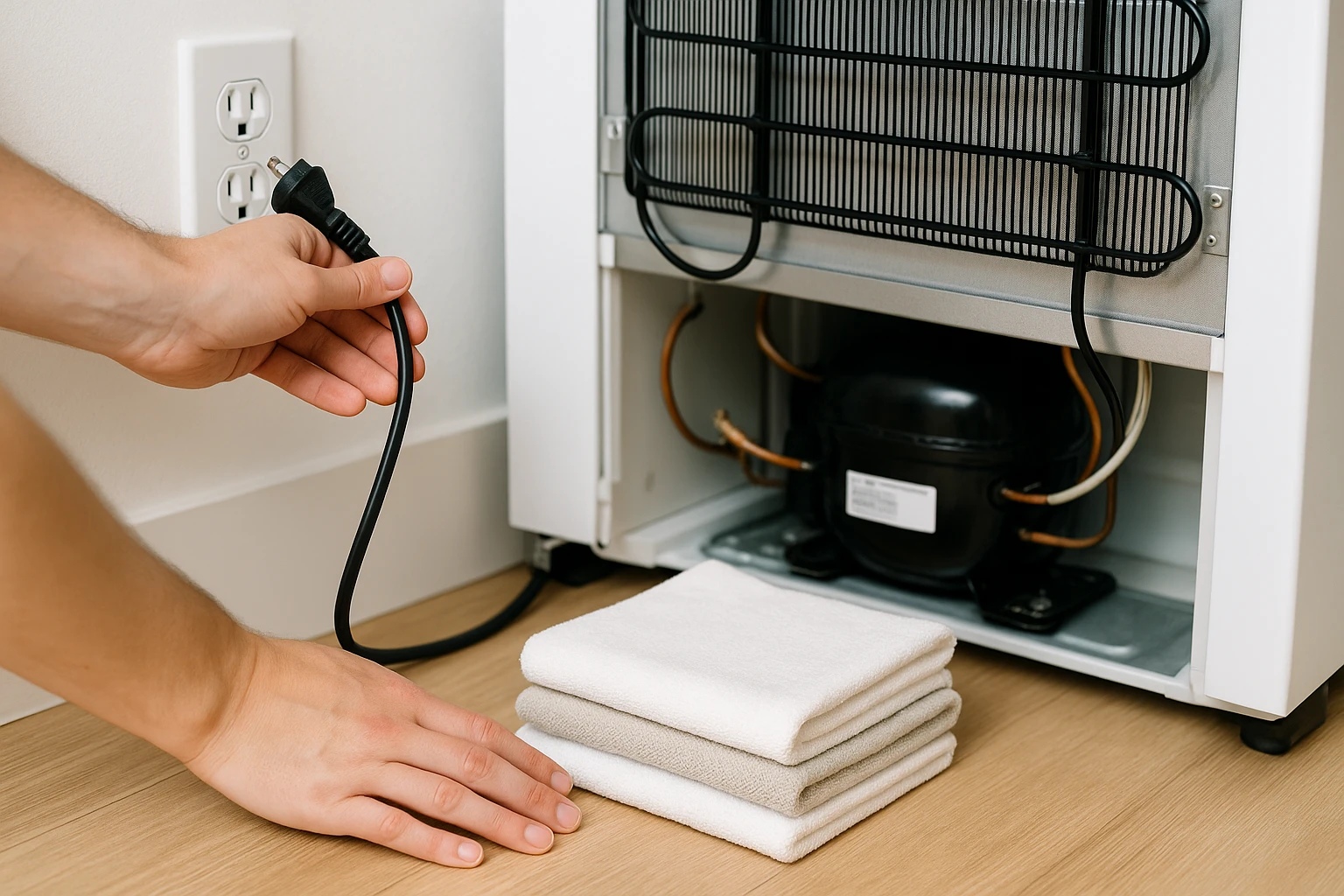Moving to a new home with all your appliances in tow? Don’t let a broken fridge or damaged washer turn your fresh start into a costly nightmare! I’ll never forget my first big move – watching in horror as my supposedly “professional” movers dragged my brand-new dishwasher across the concrete, leaving scratches that looked like abstract art (and not the good kind). That expensive lesson taught me everything I needed to know about appliance safety during moves.  Whether you’re relocating across Coquitlam or making a cross-country journey, your appliances represent a significant investment that deserves proper care and attention. The good news is that with the right preparation, techniques, and knowledge, you can ensure your refrigerator, washing machine, dryer, and other essential appliances arrive at your new home in perfect working condition. Moving appliances isn’t just about having strong arms and a big truck – it’s about understanding the unique requirements each appliance has for disconnection, transportation, and reconnection. From properly draining your washing machine to securing the drum, to ensuring your refrigerator stays upright and settles correctly, every step matters. The process involves careful planning, specialized equipment, and often the expertise of professional appliance movers who understand these intricate requirements. The stakes are particularly high when you consider that improper handling can result in expensive repairs or complete replacement of your appliances. A damaged compressor in your refrigerator or a misaligned drum in your washing machine can cost hundreds or even thousands of dollars to fix. That’s why taking the time to learn proper disconnection procedures, safe transportation methods, and correct reconnection techniques isn’t just helpful – it’s essential for protecting your investment and ensuring your new home is ready for comfortable living from day one.
Whether you’re relocating across Coquitlam or making a cross-country journey, your appliances represent a significant investment that deserves proper care and attention. The good news is that with the right preparation, techniques, and knowledge, you can ensure your refrigerator, washing machine, dryer, and other essential appliances arrive at your new home in perfect working condition. Moving appliances isn’t just about having strong arms and a big truck – it’s about understanding the unique requirements each appliance has for disconnection, transportation, and reconnection. From properly draining your washing machine to securing the drum, to ensuring your refrigerator stays upright and settles correctly, every step matters. The process involves careful planning, specialized equipment, and often the expertise of professional appliance movers who understand these intricate requirements. The stakes are particularly high when you consider that improper handling can result in expensive repairs or complete replacement of your appliances. A damaged compressor in your refrigerator or a misaligned drum in your washing machine can cost hundreds or even thousands of dollars to fix. That’s why taking the time to learn proper disconnection procedures, safe transportation methods, and correct reconnection techniques isn’t just helpful – it’s essential for protecting your investment and ensuring your new home is ready for comfortable living from day one.
Key Outtakes:
- Professional appliance disconnection requires turning off utilities, draining water lines, and securing moving parts before transport
- Proper transportation involves using heavy-duty dollies, furniture straps, and protective padding to prevent damage during the move
- Reconnection procedures must include proper settling time for refrigerators and careful alignment for washing machines and dryers
- Professional appliance moving services in Coquitlam offer specialized equipment and expertise for complex relocations
- Safety preparation includes clearing pathways, having emergency contacts ready, and understanding when to call professionals

Understanding Appliance Moving Challenges
Moving appliances presents unique challenges that go far beyond the typical boxes and furniture you’ll encounter during a relocation. Unlike other household items that can simply be wrapped and loaded onto a truck, appliances contain delicate mechanical components, electrical systems, and often plumbing connections that require specialized handling. Each type of appliance – whether it’s your refrigerator, washing machine, dryer, or dishwasher – has specific vulnerabilities that can lead to costly damage if not properly addressed during the moving process.  The complexity increases when you consider that many modern appliances contain sophisticated electronic controls, sensors, and computerized systems that can be damaged by improper handling or transportation vibrations. Your refrigerator’s compressor system, for instance, contains refrigerant lines and oil that must remain in proper position to function correctly. Similarly, washing machines have sophisticated drum suspension systems that can be permanently damaged if the drum isn’t properly secured before moving. These aren’t issues you’ll face when moving a couch or dining table. Weight and size present additional challenges that many homeowners underestimate. A standard refrigerator can weigh between 200-400 pounds, while a washer and dryer set can easily exceed 500 pounds combined. This isn’t just about having enough people to lift – it’s about having the right equipment, technique, and understanding of how to maneuver these bulky items through doorways, around tight corners, and up or down stairs safely. Professional appliance movers understand these challenges and come equipped with specialized dollies, straps, and protective materials designed specifically for appliance transportation. The environmental factors during transport also play a crucial role in appliance safety. Temperature fluctuations, humidity, and vibration during transport can all affect sensitive components. Refrigerators and freezers are particularly susceptible to temperature changes that can affect their cooling systems, while electronic components in modern appliances can be damaged by excessive vibration or moisture exposure. Understanding these factors and how to mitigate them is essential for successful appliance relocation, whether you’re handling the move yourself or working with professional moving services in the Coquitlam area.
The complexity increases when you consider that many modern appliances contain sophisticated electronic controls, sensors, and computerized systems that can be damaged by improper handling or transportation vibrations. Your refrigerator’s compressor system, for instance, contains refrigerant lines and oil that must remain in proper position to function correctly. Similarly, washing machines have sophisticated drum suspension systems that can be permanently damaged if the drum isn’t properly secured before moving. These aren’t issues you’ll face when moving a couch or dining table. Weight and size present additional challenges that many homeowners underestimate. A standard refrigerator can weigh between 200-400 pounds, while a washer and dryer set can easily exceed 500 pounds combined. This isn’t just about having enough people to lift – it’s about having the right equipment, technique, and understanding of how to maneuver these bulky items through doorways, around tight corners, and up or down stairs safely. Professional appliance movers understand these challenges and come equipped with specialized dollies, straps, and protective materials designed specifically for appliance transportation. The environmental factors during transport also play a crucial role in appliance safety. Temperature fluctuations, humidity, and vibration during transport can all affect sensitive components. Refrigerators and freezers are particularly susceptible to temperature changes that can affect their cooling systems, while electronic components in modern appliances can be damaged by excessive vibration or moisture exposure. Understanding these factors and how to mitigate them is essential for successful appliance relocation, whether you’re handling the move yourself or working with professional moving services in the Coquitlam area.
Pre-Move Preparation and Safety Assessment
Before you even think about disconnecting your first appliance, a comprehensive safety assessment and preparation phase is absolutely critical for a successful move. This preparation begins several weeks before your moving date and involves evaluating your current setup, planning your approach, and gathering the necessary tools and resources. The goal is to identify potential challenges early and create a detailed plan that minimizes risks to both your appliances and your property. Start by conducting a thorough inventory of all appliances that need to be moved, documenting their make, model, age, and current condition. Take photos of each appliance from multiple angles, including any existing scratches or dents, and note the location of all connection points. This documentation serves multiple purposes – it helps you understand what you’re working with, provides a baseline for insurance purposes, and can be invaluable if you need to reference installation manuals or contact manufacturers for specific moving guidance. The physical assessment of your move route is equally important. Measure doorways, hallways, stairwells, and any tight corners between your appliances’ current locations and the exit points. Don’t forget to measure the entry points at your new home as well. Many moving disasters occur when homeowners realize too late that their refrigerator won’t fit through a particular doorway or that their washing machine can’t be maneuvered down a narrow basement staircase. Create a detailed floor plan showing the optimal path for each appliance, noting any obstacles or challenges. Safety equipment and tool preparation should be your next priority. Essential items include appliance dollies rated for the weight of your specific appliances, furniture straps and tie-downs, moving blankets or protective padding, basic hand tools for disconnection, and utility shut-off tools. If you’re planning to handle the move yourself, invest in quality equipment rather than trying to make do with inadequate tools. The cost of proper equipment is minimal compared to the potential expense of appliance damage or personal injury. Consider your physical capabilities and limitations honestly. Moving appliances is demanding physical work that requires not just strength, but also proper technique and coordination. If you have any back problems, joint issues, or other physical limitations, seriously consider hiring professional appliance movers. Even if you’re physically capable, having help from experienced professionals can prevent costly mistakes and ensure your appliances are handled with the expertise they deserve. Professional services in Coquitlam have the experience, equipment, and insurance coverage to handle complex appliance moves safely and efficiently.
Proper Appliance Disconnection Procedures
The disconnection phase is where many DIY appliance moves go wrong, often because homeowners rush through this critical step or don’t fully understand the specific requirements for each appliance type. Proper disconnection isn’t just about unplugging from the wall – it involves safely shutting off utilities, draining water systems, securing moving parts, and preparing each appliance for transport in a way that protects its internal components and prevents damage to your home.
Refrigerator and Freezer Disconnection
Refrigerators require the most advance planning of any major appliance due to their complex cooling systems and the need to properly defrost and clean them before moving. Begin the process at least 24-48 hours before your move date by consuming or relocating all perishable items. Turn off the unit and unplug it from the electrical outlet, then prop open all doors to allow for complete defrosting. Place towels around the base to catch melting ice and water.  Once completely defrosted, thoroughly clean the interior with a mild soap solution and allow it to dry completely. This prevents mold and odor development during transport and storage. Remove all removable components including shelves, drawers, and ice makers, packing them separately with protective wrapping. If your refrigerator has an automatic ice maker, disconnect the water line using the shut-off valve typically located behind the unit or under the kitchen sink. Have a bucket ready to catch any residual water in the lines. The exterior cleaning is equally important – clean the coils on the back or bottom of the unit to remove dust and debris that could affect performance after reinstallation. Secure the doors with appliance-specific tape or rope, but avoid using regular duct tape directly on the finish as it can leave residue. For models with leveling legs, consider adjusting them to their lowest position to reduce the overall height for easier transport through doorways.
Once completely defrosted, thoroughly clean the interior with a mild soap solution and allow it to dry completely. This prevents mold and odor development during transport and storage. Remove all removable components including shelves, drawers, and ice makers, packing them separately with protective wrapping. If your refrigerator has an automatic ice maker, disconnect the water line using the shut-off valve typically located behind the unit or under the kitchen sink. Have a bucket ready to catch any residual water in the lines. The exterior cleaning is equally important – clean the coils on the back or bottom of the unit to remove dust and debris that could affect performance after reinstallation. Secure the doors with appliance-specific tape or rope, but avoid using regular duct tape directly on the finish as it can leave residue. For models with leveling legs, consider adjusting them to their lowest position to reduce the overall height for easier transport through doorways.
Washing Machine Preparation
Washing machine disconnection involves multiple systems that must be addressed in the correct order to prevent water damage and protect the internal components. Start by running a final empty cycle with hot water to clean out any detergent residue and then unplug the machine. Turn off the hot and cold water supply valves completely. Using pliers, carefully disconnect the water supply hoses from both the wall and the back of the machine. Have a bucket and towels ready to catch any water remaining in the hoses. Place the hoses and power cord inside the washing machine drum to keep them secure. Finally, and most critically, install washing machine shipping bolts (also known as transit bolts) to secure the drum. These bolts prevent the drum and suspension system from bouncing around during transport, which is a leading cause of damage. If you no longer have the original bolts, you can usually order replacements from the manufacturer.